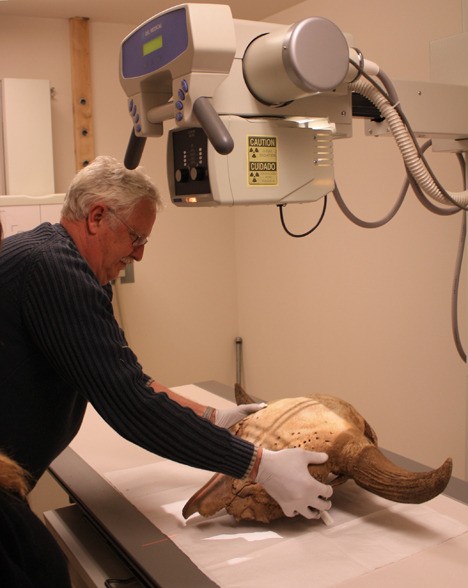Archaeologist Steve Kenady examined the bones of an ancient, extinct giant bison by x-ray today at Orcas Family Health Center, unarguably the clinic’s oldest “patient”.
Kenady was checking for remnants of stone tools that could have been used to slaughter the animal, but the scans revealed nothing but bison bone. The discovery roughly four years ago piqued curiosity in the global scientific community, inspiring new theories of human migration to the Pacific coast because some of the bones bear the marks of human butchery using stone tools. Earlier theories had maintained that the Clovis people were the earliest inhabitants of the region, but the bones, estimated by radiocarbon dating in an Irvine lab to be roughly 14,000 years old, pre-date the Clovis era by 800 years.
Kenady, along with Michael Wilson, Randall Schalk and Robert Mierendorf, have authored scientific papers regarding the discovery. The first, “Indications of Butchering on a Late-Pleistocene Bison antiquus from the Maritime Pacific Northwest”, was published in 2007. A later piece, called “Late Pleistocene Bison antiquus from Orcas Island, Washington, and the biogeographic importance of an early postglacial land mammal dispersal corridor from the mainland to Vancouver Island”, was published in the Quaternary Research journal in January 2009. In April 2010 the group published “Late Pleistocene Butchered Bison antiquus from Ayer Pond, Orcas Island, Pacific Northwest: Age Confirmation and Taphonomy”, concluding, “the bison was butchered by humans shortly after deglaciation”.
An Archaeological Research Associate with the Orcas Island Historical Museum, which caretakes the bison bones, Kenady said the skeleton represents “the most complete Bison antiquus anywhere, the most bones”. The bison was discovered during the excavation of a peat bog on Nancy and Tony Ayer’s property, near Obstruction Pass on Orcas Island. Since 1957, bones from at least 10 bison have been discovered in Orcas peat bogs.
The skull from Ayer pond cannot be placed on display as it is not fully fossilized, and must not be exposed to ultraviolet light or human touch. Museum representatives hope to create a plaster replica sometime in the future for display.




